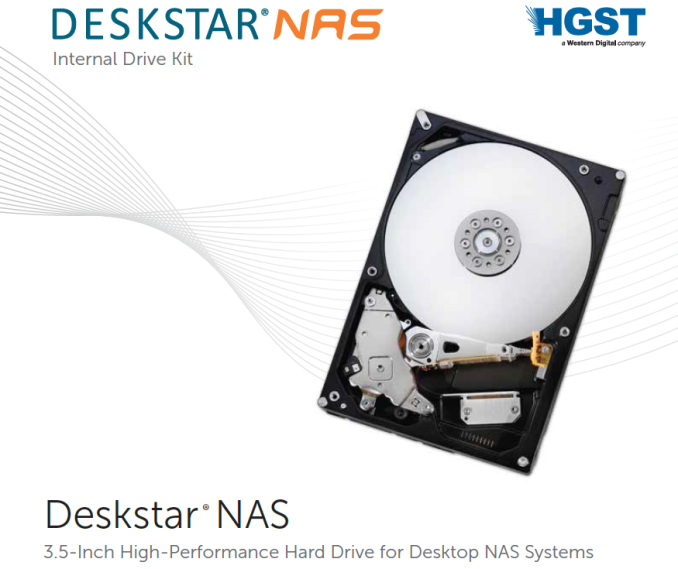HGST Deskstar NAS 4 TB Review
by Ganesh T S on November 22, 2014 2:00 PM ESTConcluding Remarks
The HGST Deskstar NAS 4 TB has been evaluated for both NAS and DAS applications and the numbers put up for comparison against other 4 TB drives targeting this market segment. As expected, there is no 'one size fits all' model in this area. The various hard drives in the comparison lot were launched targeting different markets and their resulting performance varies accordingly.
Thanks to the 7200 RPM speeds, the HGST Deskstar NAS does manage to acquit itself well in the overall performance category. Though it is not the absolute best, it performs admirably well in the random access patterns segment of the multi-client evaluation.
The HGST Deskstar NAS doesn't deliver the lowest power consumption. Those were recorded, as expected, with the 5400/5900 RPM drives: the WD Reds, Seagate NAS HDDs and the Seagate Terascale units. However, the Deskstar NAS manages to almost win the efficiency category - thanks to the great balance between speed and power consumption. The energy consumption for the resync process was bettered only by the Seagate Enterprise Capacity v4 (which comes with a much higher price tag).
In terms of pricing, the HGST Deskstar NAS wins comfortably. It is, by far, the most price effective 7200 rpm 4 TB drive in this market segment. The closest competitor is the WD Red Pro, which retails for at least $50 more. At $185, the Deskstar NAS is beaten in price only by the WD Red and the Seagate NAS HDD (both of which come in around the $170 range).
There are plenty of options for NAS users looking to stock up their NAS units with high capacity drives. Though not at the bleeding edge of capacity, today's 4TB drives offer a good mix of pricing, performance, and capacity. For the cautious buyer, 4 TB drives offer an alternative to the potential risk in going the new technology route with 6 TB drives. With the right data in hand, it's easy enough to find the best fit by taking into consideration the expected workload and desired price points.The overall verdict is that the HGST Deskstar NAS is a cost-effective solution for scenarios where non-sequential workloads with simultaneous multi-client accesses are common











39 Comments
View All Comments
abhaxus - Sunday, November 23, 2014 - link
According to WD, the Red Pro is rated at 1 in 10^15 not 10^14 before URE. Are you working from some other data or is your comparison chart inaccurate? Planning on purchasing several drives in the next few weeks and that was going to be the key factor in my decision.ganeshts - Sunday, November 23, 2014 - link
Thanks for bringing this to my attention.When the WD Red Pro was launched, the datasheet had URE < 10 in 10^15, which I had denoted as 1 in 10^14 in our initial review. Backed up by a third-party post on another forum here: http://www.techpowerup.com/forums/threads/western-...
It looks like WD has fixed this 'error' in their latest datasheet. I will update the table shortly.
abhaxus - Monday, November 24, 2014 - link
I do remember that from their launch now that you mention it. Still torn about my purchase.Julian Boolean - Saturday, December 5, 2015 - link
Fact : As of Today (Dec 5th 2015) the Western Digital Spec Sheet for The Red Pro STILL lists the URE rate as 10 in 10^15. It is not "a mistake in the specs sheet". It has been listed that way since product launch and has never been corrected. 1 in 10^14 = 10 in 10^15. This is a 1 in 10^14 drive. I called WD myself to confirm this. Three days later I got the answer I suspected all along. It IS 10 in 10^15 ( which equals 1 in 10^14). This is just clever marketing, and it irks me to no end that countless review sites such as this have incorrectly listed the URE rates.I cannot tell you how many review sites have made the mistake of listing it as 1 in 10^15.
jota83 - Monday, November 24, 2014 - link
Read throughly the backblaze report on reliability of hard-disks, as pointed out above. HGST (former hitachi) build very robust hard disks, and they deal with vibration pretty good. Thats one of the factors (not sure if mentioned in the article) that the NAS deskstar incorporates,and which could be rated as "enterprise only".Mikemk - Sunday, November 23, 2014 - link
I'd like to see http://www.newegg.com/Product/Product.aspx?Item=N8... reviewedAbRASiON - Sunday, November 23, 2014 - link
7200rpm? Sorry but as far as I'm concerned, that's not a NAS drive. Nope nope nope nope and nope. Too hot, too noisy, silly - just silly design choice.Daiz - Sunday, November 23, 2014 - link
hmm, you might want to tell the likes of HP about that since they let you stuff their NAS appliances with up to 15k RPM drives. Not all NAS appliances sit in your living room ;)MikeMurphy - Sunday, November 23, 2014 - link
Reliability of HDDs has become a huge problem. I bought this drive as it's apparently the most reliable consumer mechanical drive out there. I was hoping there would be some commentary on this.NoSoMo - Monday, November 24, 2014 - link
Anyone interested in HDDs and their reliability should check this article out...https://www.backblaze.com/blog/hard-drive-reliabil...